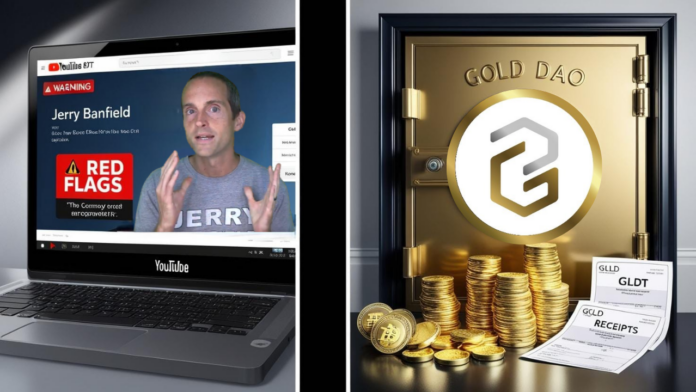Jerry Banfield’s recent video laced with accusations and heavy claims against Gold DAO has prompted a sharp and detailed response from the developers, who’ve taken the opportunity to set a few things straight. It’s a familiar pattern in the crypto space—someone fires off a sensational exposé, and the accused party has to wade through the fallout, correcting, clarifying, and in some cases, defending decisions that were already in plain sight. But in this case, the team behind Gold DAO isn’t just issuing a statement—they’re laying bare the intricacies of their operations, financing, and long-term plans to distinguish substance from speculation.
First on the chopping block is the claim that the devs paid themselves millions in ICP. The numbers say otherwise. Since launching through the Service Nervous System (SNS), the team submitted only one funding proposal for 156,746 ICP. More than a third of that, 56,746 ICP, went towards developing GLDT, the token that sits at the heart of the Gold DAO ecosystem. The remaining 100,000 ICP was used to bail out the WTN DAO, which had been floundering. One team member flew to Geneva to meet Leo and Enzo from WTN after a week of failed attempts to get their SNS off the ground. With Gold DAO’s support—both in tokens and manpower—the effort was revived. The favour wasn’t one-sided. The WTN DAO is now contributing to Gold DAO’s coding work, especially around the stablecoin project.
The dev team’s claim that around 70% of raised funds remain locked in NNS neurons doesn’t leave much wiggle room for accusations of runaway spending. These locked tokens, they say, serve the DAO’s broader goals. Since July 2024, they’ve reportedly been funding ongoing development themselves. This includes infrastructure groundwork laid back in 2023, notably the GLD NFTs, all of which were done without touching community funds.
Banfield’s video also criticises Gold DAO’s reluctance to collaborate with him on further paid content. The team makes it clear they’ve worked with him before, once on a dev-funded interview and another time via a community-backed proposal. Both videos, now deleted by Banfield, have led the team to question the permanence and accountability of paid content arrangements. His latest pitch—requesting over 230,000 GOLDAO tokens for 11 videos—was turned down. Gold DAO wanted a smaller initial project to evaluate the partnership, but Banfield reportedly walked away instead.
Marketing has been another touchpoint. Critics have interpreted the lack of mass token spending as a lack of promotion. The team disagrees. They’ve financed efforts using a mix of their own funds, ICP, and GOLDAO tokens. They highlight past campaigns such as the GLD NFT airdrop at NFT NFC in 2024, hiring social media personnel, and ambassadors. For them, marketing isn’t just about throwing tokens into giveaways or influencer deals. They claim to have taken a measured route that aligns with a long-term roadmap, where branding, relationships, and community involvement outweigh short-term visibility boosts.
Much of the Gold DAO structure rests on GLDT, a token backed by physical gold bars, each represented by a GLD NFT. The team insists this isn’t meme coin territory. They soft-launched the token in November 2024 with an emphasis on testing price stability mechanisms, steering clear of relying on oracles and instead validating price integrity via NFT-to-gold backing. They’re now entering what they describe as the growth phase.
GLDT’s traction is visible on decentralised exchanges like ICPSwap and KongSwap, where it holds a total liquidity value of around $600,000. Every unit is backed by physical gold, a significant departure from many tokens boasting liquidity but backed by volatile, unpegged assets. Plans are in place for staking and a refreshed web app, all part of a broader strategy to cement GLDT’s reputation as a stable asset token.
One of the more technical points addressed relates to the sale of GLD NFTs via Bity, a Swiss-regulated crypto broker. Questions were raised about the decentralisation of the NFTs, which Gold DAO doesn’t shy away from. Decentralisation, they argue, isn’t feasible when legal ownership of a regulated commodity like gold is involved. These NFTs are not collectibles. They represent real bars of gold stored in Switzerland, fully insured and compliant with Swiss law. That means KYC and AML processes are non-negotiable, and that’s where Bity comes in.
Bity has been around for a decade, serving over 120,000 clients and operating within regulatory frameworks since 2014. Their wallet is the first to natively support ICP, offering users the chance to buy, sell, and self-custody their assets in a regulated environment. This partnership, Gold DAO argues, strengthens their ecosystem and brings a regulated asset class into a space typically dominated by risk and speculation.
Banfield’s criticisms of the NFTs’ lack of decentralisation are countered with a dose of reality: assets backed by real-world holdings must play by real-world rules. You can’t store gold in a vault and then pretend it lives in a free-for-all ecosystem. Legal ownership, insured storage, and compliance are necessary when you’re dealing with tangible, high-value assets. On-chain decentralisation is maintained with the GLDT token, but the NFT layer can’t abandon legal accountability.
Then there’s the broader context. The team admits that building a gold-backed token isn’t easy. It takes time, caution, and a willingness to face both legal and technical hurdles. While meme tokens may flood the market overnight and vanish just as quickly, Gold DAO’s approach is intentionally slow, carefully structured, and anchored in transparency. They’re not hiding behind pseudonyms or disappearing when things get tricky. They’ve weathered audits, formed partnerships, and taken regulatory obligations seriously.
They also push back against any insinuations of links with recent events involving Yuku, pointing out that they’ve already made statements and forum posts clarifying their position. As for ORIGYN, another partner caught in Banfield’s firing line, the devs suggest his statements are simply false. ORIGYN, they say, has plenty of projects in the works, and they’re not the only ones working with the Swiss-based protocol.
There’s a certain weariness in the tone of the statement, but it doesn’t read as defensive—it reads like a team that’s been building through headwinds and has finally reached the point where they’d rather show their work than argue about it. Whether or not the wider community sees Gold DAO as a long-term bet remains to be seen. But one thing is obvious: they’re not running from questions. They’ve answered them, even when the framing has been hostile, and they’re doing it with numbers, partners, timelines, and product updates—all the things that matter when you’re trying to build trust in a volatile industry.
Whether you agree with their strategy or not, it’s hard to ignore the effort. There are no flashy slogans here, just a slow grind to build something tangible and legally sound. For a space often addicted to hype, that might be the most radical move of all.


